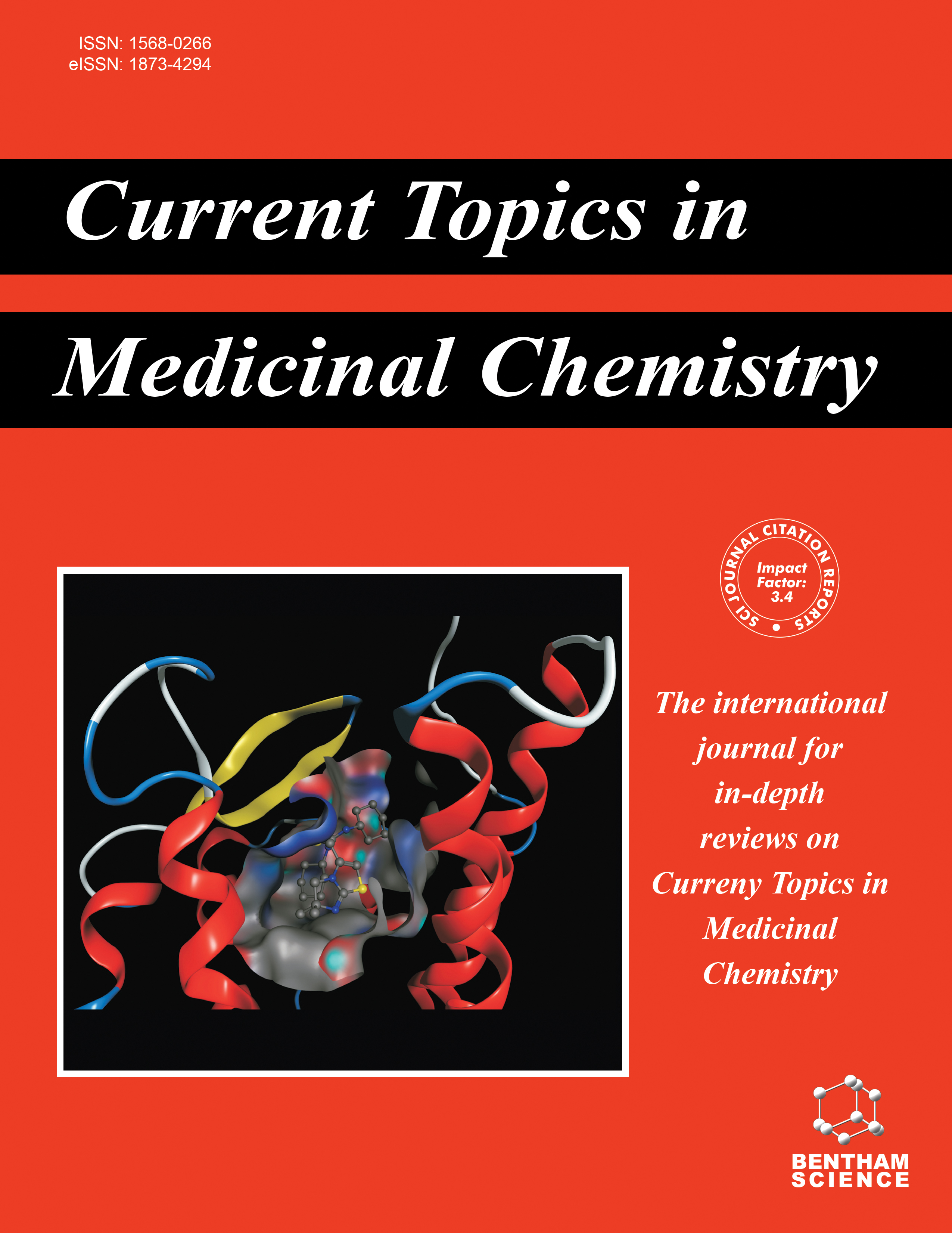- Home
- A-Z Publications
- Current Topics in Medicinal Chemistry
- Previous Issues
- Volume 17, Issue 15, 2017
Current Topics in Medicinal Chemistry - Volume 17, Issue 15, 2017
Volume 17, Issue 15, 2017
-
-
Herb Medicines against Osteoporosis: Active Compounds & Relevant Biological Mechanisms
More LessAuthors: Lei Wu, Zhuoyan Ling, Xueqin Feng, Caiping Mao and Zhice XuOsteoporosis is one of common bone disorders, affecting millions of people worldwide. Treatments of osteoporosis consist of pharmacotherapy and non-pharmacological interventions, such as mineral supplementation, lifestyle changes, and exercise programs. Due to the minimum side effects and favorable cost-effective therapeutic effects, herbal medicine has been widely applied in clinical practices for more than 2,000 years Read More
-
-
-
Antioxidative Effects of Rhodiola Genus: Phytochemistry and Pharmacological Mechanisms against the Diseases
More LessAuthors: Yongmei Li, Jue Wu, Ruixiu Shi, Na Li, Zhice Xu and Miao SunRhodiola as one of traditional medicines has been used for clinical treatments due to its strong antioxidant properties. Phytochemical analysis revealed the presence of flavonoids, phenylpropanoids, phenylethanol/benzyl alcohol derivatives, cyanogenic glycosides and terpenoids. The bioactive compounds had been demonstrated to be effective at scavenging reactive oxygen species (ROS). The structures contain phen Read More
-
-
-
Bioinformatics and Drug Discovery
More LessBy Xuhua XiaBioinformatic analysis can not only accelerate drug target identification and drug candidate screening and refinement, but also facilitate characterization of side effects and predict drug resistance. High-throughput data such as genomic, epigenetic, genome architecture, cistromic, transcriptomic, proteomic, and ribosome profiling data have all made significant contribution to mechanismbased drug discovery and dr Read More
-
-
-
Probes and Targets of DNA Methylation and Demethylation in Drug Development
More LessAuthors: Barsam Mirfattah, Jason Herring, Hui Tang and Kangling ZhangDNA methylation and demethylation is part of the essential biological processes regulating gene expression in normal cell development. Abnormal methylation status of specific genes and their irregularly translated proteins are normally associated with certain kinds of diseases or cancer. The rapid development of innovative DNA methylation mapping techniques provides a better understanding of DNA methylation pattern and Read More
-
-
-
Metabolomic Approach in Probing Drug Candidates
More LessAuthors: Chen Liu, Angelo D128;™ Alessandro and Yang XiaMetabolomics is the comprehensive characterization of endogenous small molecules metabolites, xenometabolites and their metabolisms. The recent introduction of high-throughput metabolomics approaches has fostered strides related to the capacity to in silico elaborate metabolomics data by means of system biology. Recent progresses in bioanalytical technologies assisted with algorithms enabling large-scale data anal Read More
-
-
-
LncRNA as a Therapeutic Target for Angiogenesis
More LessAuthors: Mohan M. Kumar and Ravi GoyalBackground: Out of 3 billion base pairs in human genome only ~2% code for proteins; and out of 180,000 transcripts in human cells, about 20,000 code for protein, remaining 160,000 are non-coding transcripts. Most of these transcripts are more than 200 base pairs and constitute a group of long non-coding RNA (lncRNA). Many of the lncRNA have its own promoter, and are well conserved in mammals. Accumulating evidence Read More
-
-
-
The Medicinal Chemistry of Nitrite as a Source of Nitric Oxide Signaling
More LessConventional understanding of nitric oxide (NO) signaling in biology is commonly based on the premise that it simply diffuses randomly from its site of production by NO synthases to its site of action or inactivation. This notion has been challenged on a systemic cardiovascular scale with the realization that NO has endocrine effects despite being unable to exist in blood for more than a few milliseconds. Investigation of this ph Read More
-
-
-
Single-Cell Sequencing for Drug Discovery and Drug Development
More LessAuthors: Hongjin Wu, Charles Wang and Shixiu WuNext-generation sequencing (NGS), particularly single-cell sequencing, has revolutionized the scale and scope of genomic and biomedical research. Recent technological advances in NGS and singlecell studies have made the deep whole-genome (DNA-seq), whole-epigenome and whole-transcriptome sequencing (RNA-seq) at single-cell level feasible. NGS at the single-cell level expands our view of genome, epigenome an Read More
-
-
-
Computational Modeling Approach in Probing the Effects of Cytosine Methylation on the Transcription Factor Binding to DNA
More LessAuthors: John Tenayuca, Kimberley Cousins, Shumei Yang and Lubo ZhangIntroduction: Cytosine methylation at CpG dinucleotides is a chief mechanism in epigenetic modification of gene expression patterns. Previous studies demonstrated that increased CpG methylation of Sp1 sites at -268 and -346 of protein kinase C promoter repressed the gene expression. Materials & Methods: The present study investigated the impact of CpG methylation on the Sp1 binding via molecular modeling and elec Read More
-
-
-
Proteomic Analysis of Endothelin-1 Targets in the Regulation of Cardiomyocyte Proliferation
More LessAuthors: Alexandra N. Shin, Chiranjib Dasgupta, Guangyu Zhang, Kala Seal and Lubo ZhangHypoxia is a fetal stressor that leads to the production of endothelin-1 (ET-1). Previous work has shown that ET-1 treatment leads to the premature terminal differentiation of fetal cardiomyocytes. However, the precise mechanism is unknown. We tested the hypothesis that the fetal cardiomyocyte proteome will be greatly altered due to ET-1-treatment, which reveals a potential molecular mechanism of ET-1-induced Read More
-
Volumes & issues
-
Volume 25 (2025)
-
Volume 24 (2024)
-
Volume 23 (2023)
-
Volume 22 (2022)
-
Volume 21 (2021)
-
Volume 20 (2020)
-
Volume 19 (2019)
-
Volume 18 (2018)
-
Volume 17 (2017)
-
Volume 16 (2016)
-
Volume 15 (2015)
-
Volume 14 (2014)
-
Volume 13 (2013)
-
Volume 12 (2012)
-
Volume 11 (2011)
-
Volume 10 (2010)
-
Volume 9 (2009)
-
Volume 8 (2008)
-
Volume 7 (2007)
-
Volume 6 (2006)
-
Volume 5 (2005)
-
Volume 4 (2004)
-
Volume 3 (2003)
-
Volume 2 (2002)
-
Volume 1 (2001)
Most Read This Month
Article
content/journals/ctmc
Journal
10
5
false
en


